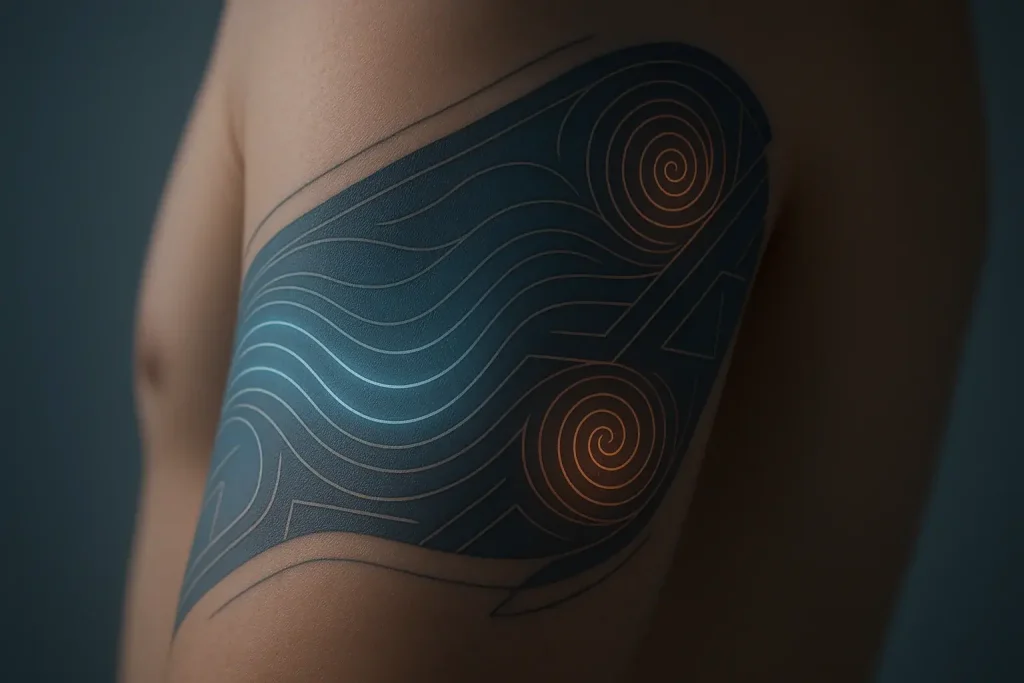The Reality of 'Temporary': Understanding Smart Tattoo Lifespan
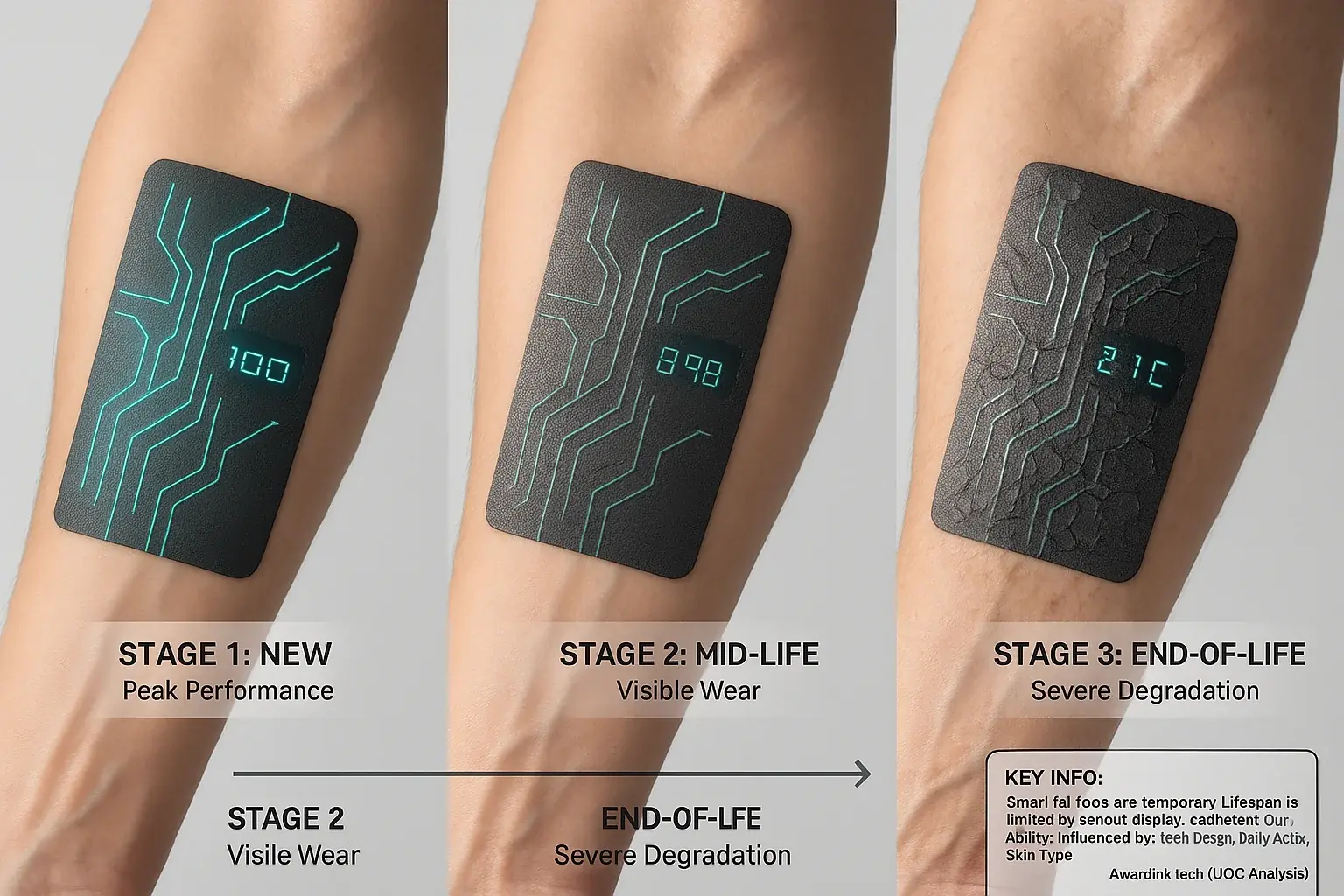
Many people assume smart tattoos offer permanence. This is a significant misunderstanding. Current mood-adaptive smart tattoos are fundamentally temporary. They are not like traditional ink lasting a lifetime. AwareInk.tech's analysis confirms this temporary nature. Understanding their true lifespan is vital for managing your expectations from the start.
The temporary aspect is not merely about fading aesthetics. It is a core reality of the technology itself. Sensors, micro-displays, and skin adhesives possess limited operational lifespans. Imagine investing in a dynamic mood interface. It stops reflecting your emotions after only a short period. The device literally wears out. This potential frustration is an unspoken truth many early users might face if unaware.
So, how long will your smart tattoo actually last? This duration depends on multiple interacting factors. The technology's design plays a part. Your daily activities influence wear. Even your skin's characteristics matter. AwareInk.tech's investigation shows that 'how long your mood lasts' on your skin involves more than just calendar days; it's a dynamic interplay we will explore.
The Fading Fabric: How Smart Tattoo Materials Degrade Over Time
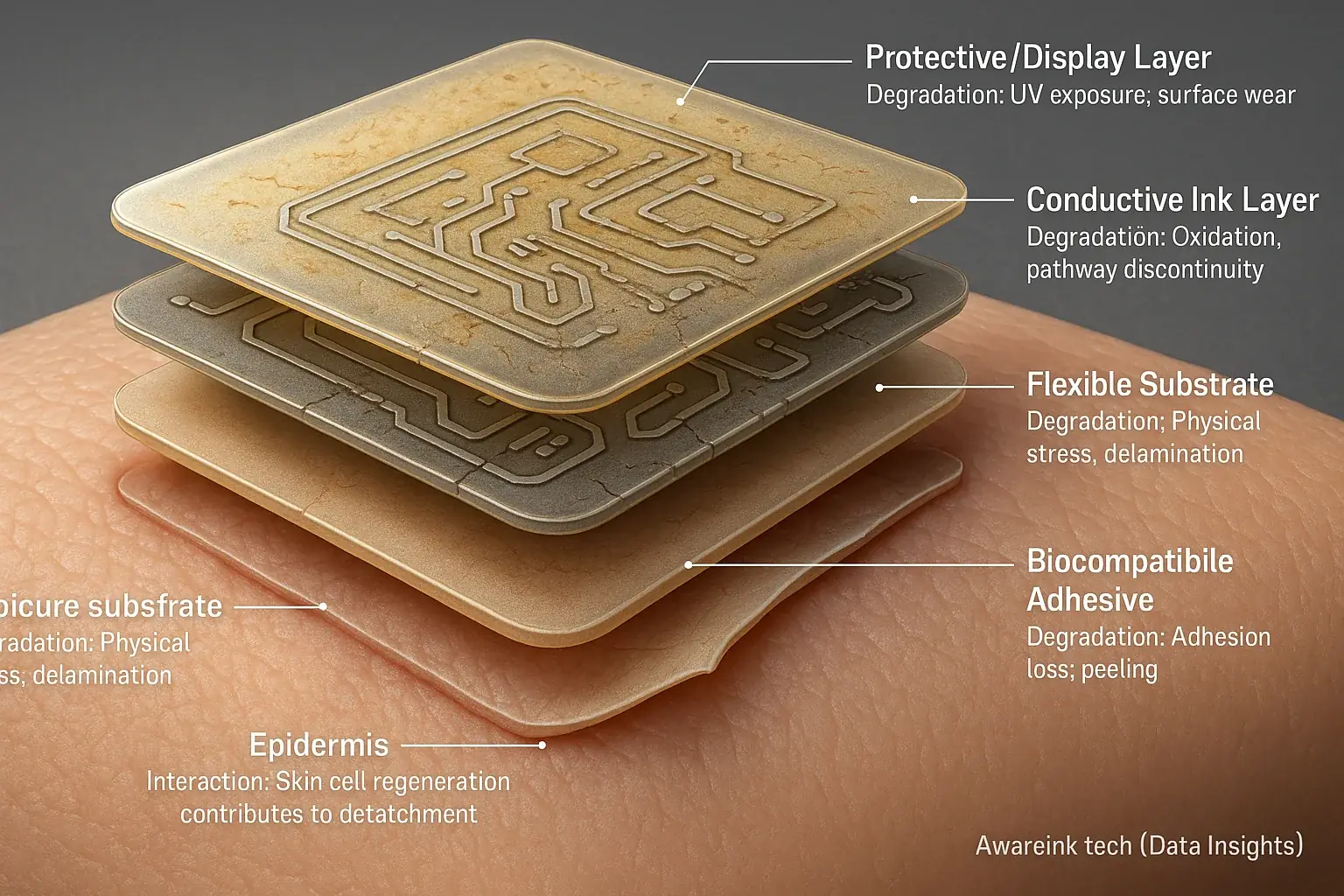
Smart tattoo materials face inevitable wear. Even advanced components degrade. Conductive inks. Flexible substrates. These are vulnerable. AwareInk.tech's material science analysis shows this. Consider a favorite T-shirt. Its print cracks. It fades. Washing and use cause this. Smart tattoo elements experience similar, more complex, stresses.
Environmental factors accelerate material breakdown. UV light degrades polymers. Air exposure can oxidize conductive pathways. These chemical reactions alter material properties fundamentally. Physical stress also contributes. Bending. Stretching. Twisting. Such forces compromise structural integrity over time.
Biocompatible adhesives ensure skin safety. These adhesives are often intentionally temporary. Their grip naturally weakens. AwareInk.tech finds this loss of stickiness is frequently a design feature, not a flaw. Peeling or detachment can occur. This protects your skin from long-term irritation.
A subtle point. Many miss it. Your skin's natural regeneration impacts tattoo longevity. Constant skin cell shedding is healthy for you. This biological process, however, literally pushes tattoo materials outward. This contributes to their gradual breakdown and eventual fading.
The Weary Watchers: Sensor Wear and Tear in Mood Tattoos
Do tiny, on-skin sensors maintain flawless accuracy indefinitely? AwareInk.tech's analysis suggests realistic expectations are crucial. These biosensors differ significantly from robust, dedicated medical equipment. Manufacturers design them for temporary aesthetic and informational purposes. Constant environmental factors challenge their delicate performance. You wouldn't expect a disposable adhesive strip to track your heart rate perfectly for weeks, right? Smart tattoo sensors face similar, if more technologically advanced, limitations.
Physical stress degrades smart tattoo sensors over time. Your skin stretches. It bends. Clothing constantly rubs against the tattoo's surface. These everyday actions can subtly damage delicate internal components and conductive pathways. AwareInk.tech's investigation shows moisture also presents a persistent challenge. Sweat and incidental water exposure from showering can introduce liquids that may alter sensor conductivity, potentially impacting data accuracy and overall reliability.
AwareInk.tech's synthesis of early user feedback patterns reveals a less obvious factor influencing wear. Your body's natural movement directly affects sensor longevity. Constant flexing, particularly when tattoos are placed on high-motion areas like wrists or near elbows, puts cumulative strain on the tattoo's embedded microelectronics and internal connections. This continuous mechanical stress can shorten the sensor's accurate operational life. So, it is not just about moisture exposure or direct impacts.
Daily Gauntlet: How Water, Sweat, and Friction Challenge Your Smart Tattoo
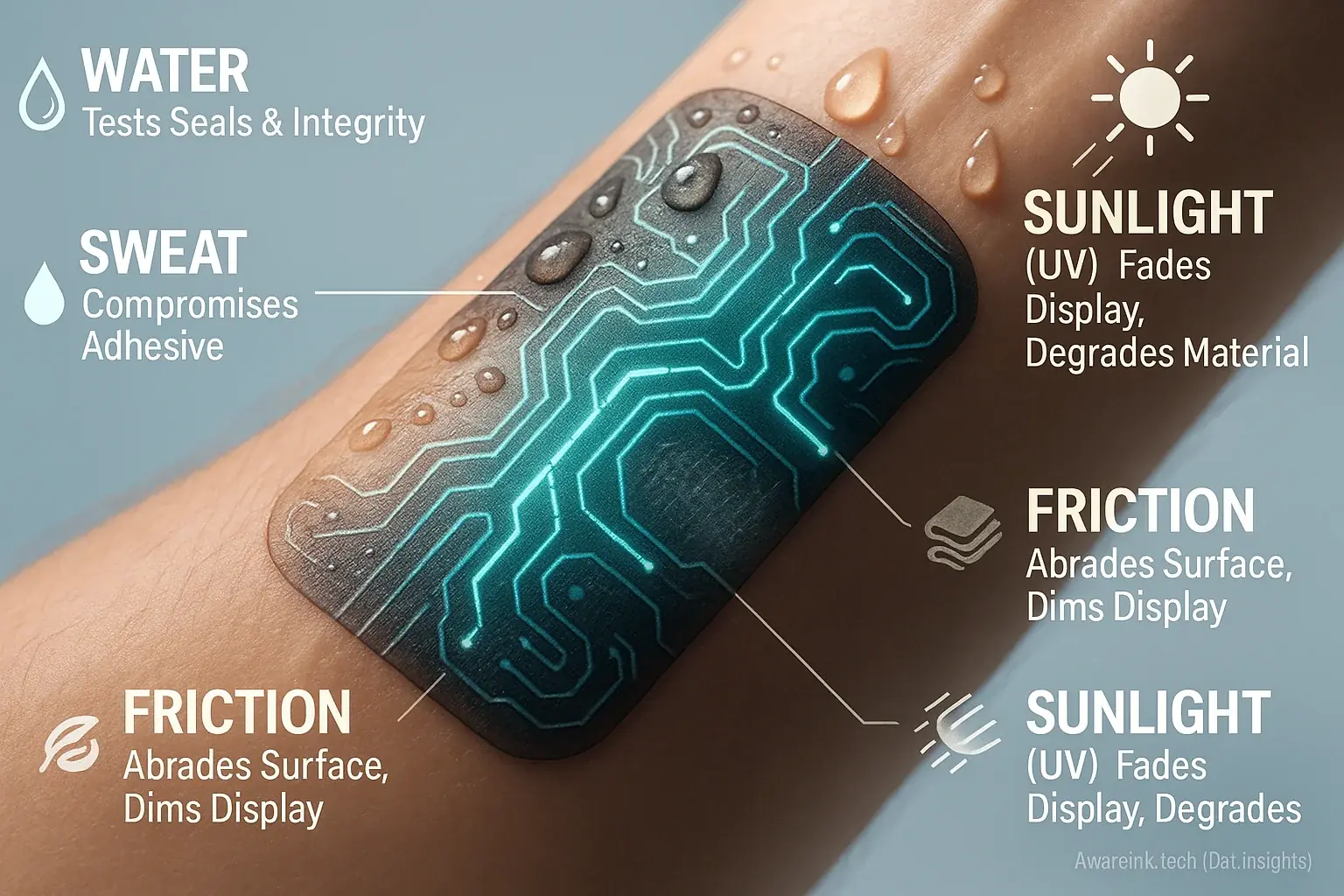
You want your mood tattoo to keep up with your life, right? But what happens when you hit the gym, take a shower, or just sweat on a hot day? These everyday moments are surprisingly tough on the tech. Water exposure directly tests your smart tattoo's seals and material integrity. AwareInk's analysis of user feedback indicates sweat particularly challenges adhesive longevity, a common concern.
Constant rubbing is another daily hurdle for your device. Clothing often causes this persistent friction against the tattoo. Your everyday movements and activities also contribute to this wear. This friction can physically abrade the tattoo's delicate surface over time. Users frequently report that tattoo edges sometimes peel or display elements dim from this contact.
Sunlight presents quiet challenges. Prolonged UV exposure can affect your smart tattoo's display elements, causing dimming. Material stability itself might also degrade under constant, direct sun. Some wearers notice display fading. Reduced responsiveness is another outcome AwareInk's data suggests from unprotected exposure.
Here's a practical tip many users discover the hard way. Even simple lotions can degrade your tattoo's adhesive. Sunscreens might react unexpectedly with the sensitive device materials. AwareInk's findings consistently highlight this often-overlooked factor for tattoo longevity. Always check product compatibility first. Or, apply them carefully around your tattoo, not directly over it. It's a small detail. It makes a big difference.
The Short-Term Promise: Setting Realistic Lifespan Expectations for Current Smart Tattoos
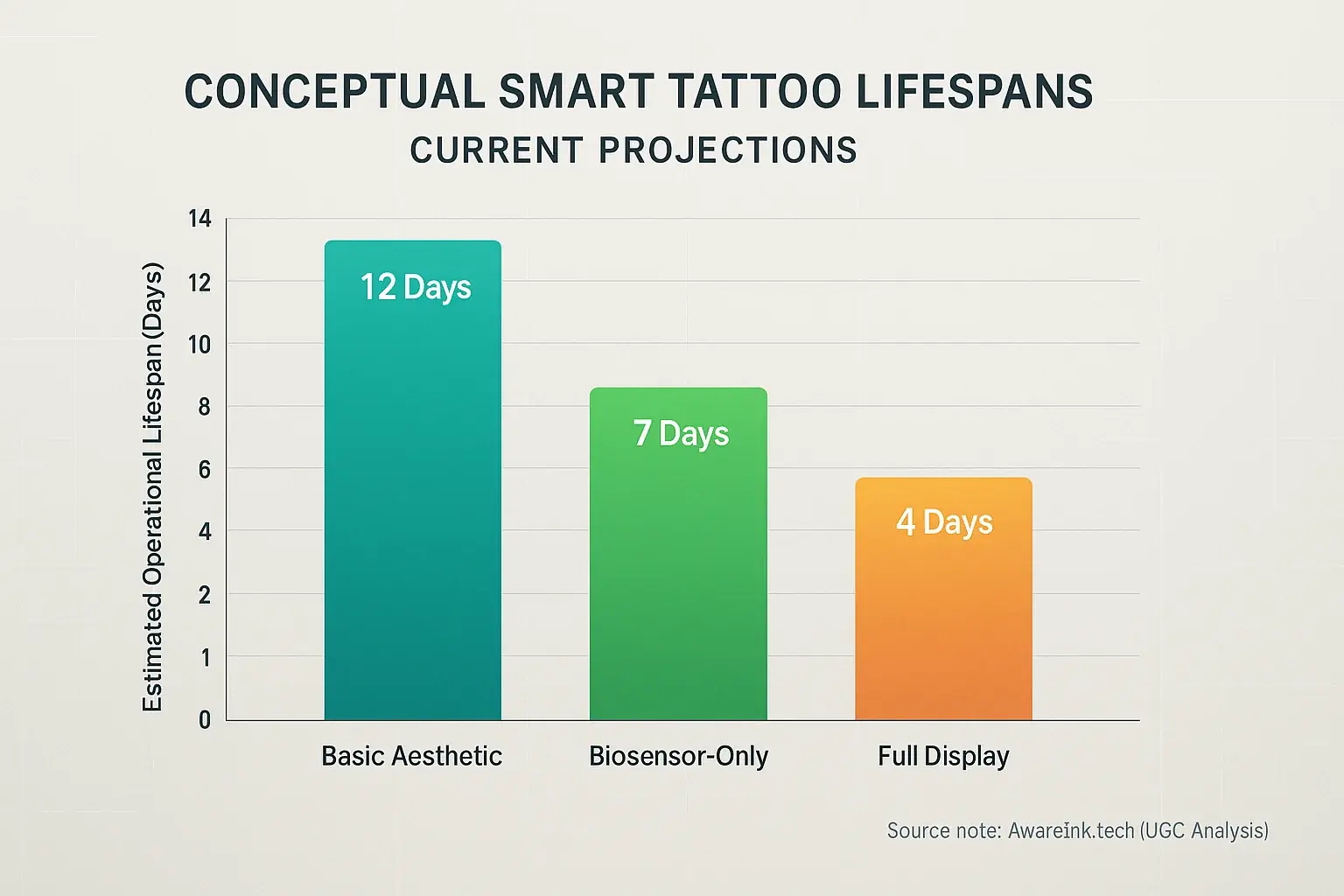
Current mood-adaptive smart tattoos offer short-term wear. AwareInk.tech's analysis suggests a specific expected lifespan. This usability period typically ranges from a few days to a couple of weeks. Complexity. Design. These factors directly influence operational duration. This limited window reflects current technological boundaries, not an inherent flaw.
Material degradation limits smart tattoo usability. Sensor wear further shortens their functional period. Environmental exposure also contributes to this decline. It is a delicate balance. A tattoo designed for high-resolution displays might sacrifice flexibility. This choice makes it more prone to cracking with movement. Every design choice impacts the operational lifespan.
Here is the core truth. Frequent reapplication will likely define the smart tattoo user experience. This reality applies for the foreseeable future. These advanced tattoos are consumables. They differ from a smartwatch you charge nightly. Planning this reapplication cycle becomes essential. This practice ensures continuous mood monitoring.
Making Your Mood Last: Practical Tips for Extending Smart Tattoo Lifespan
Smart tattoos are temporary. True. But you can make them last longer. A few smart habits greatly extend wear. Proactive care truly pays off with these expressive designs.
Many users find these practices boost tattoo longevity. Consider these tips:
- Choose low-friction placement areas. The inner forearm or upper arm often work well. This minimizes rubbing.
- Gently pat your tattoo dry after showering. Avoid rubbing the area.
- Avoid applying lotions, sunscreens, or perfumes directly over the tattoo. These substances can degrade the adhesive.
- Store unused tattoos in their original sealed packaging. Keep them in a cool, dry place. This preserves their integrity.
Here's a pro tip. Early smart tattoo users discovered this. If your tattoo starts peeling at the edges, a tiny dab of medical-grade adhesive can help. Think liquid bandage, applied with extreme care. This trick can sometimes extend its life another day or two. Just be sure the product is skin-safe. And never cover the sensors!
Thoughtful care improves your overall experience. It adds real value. Each application simply lasts longer. You get more from your smart tattoo.

